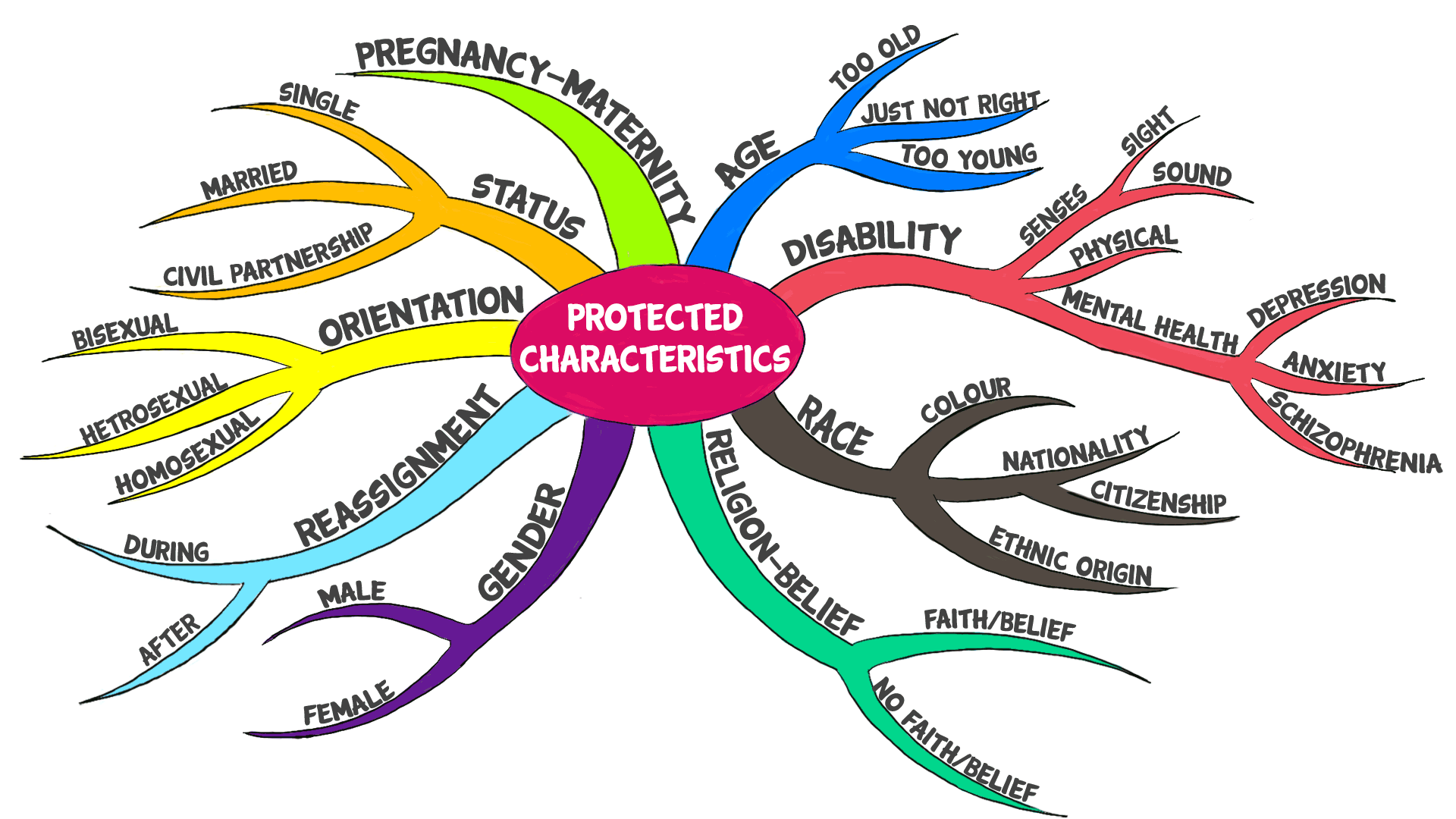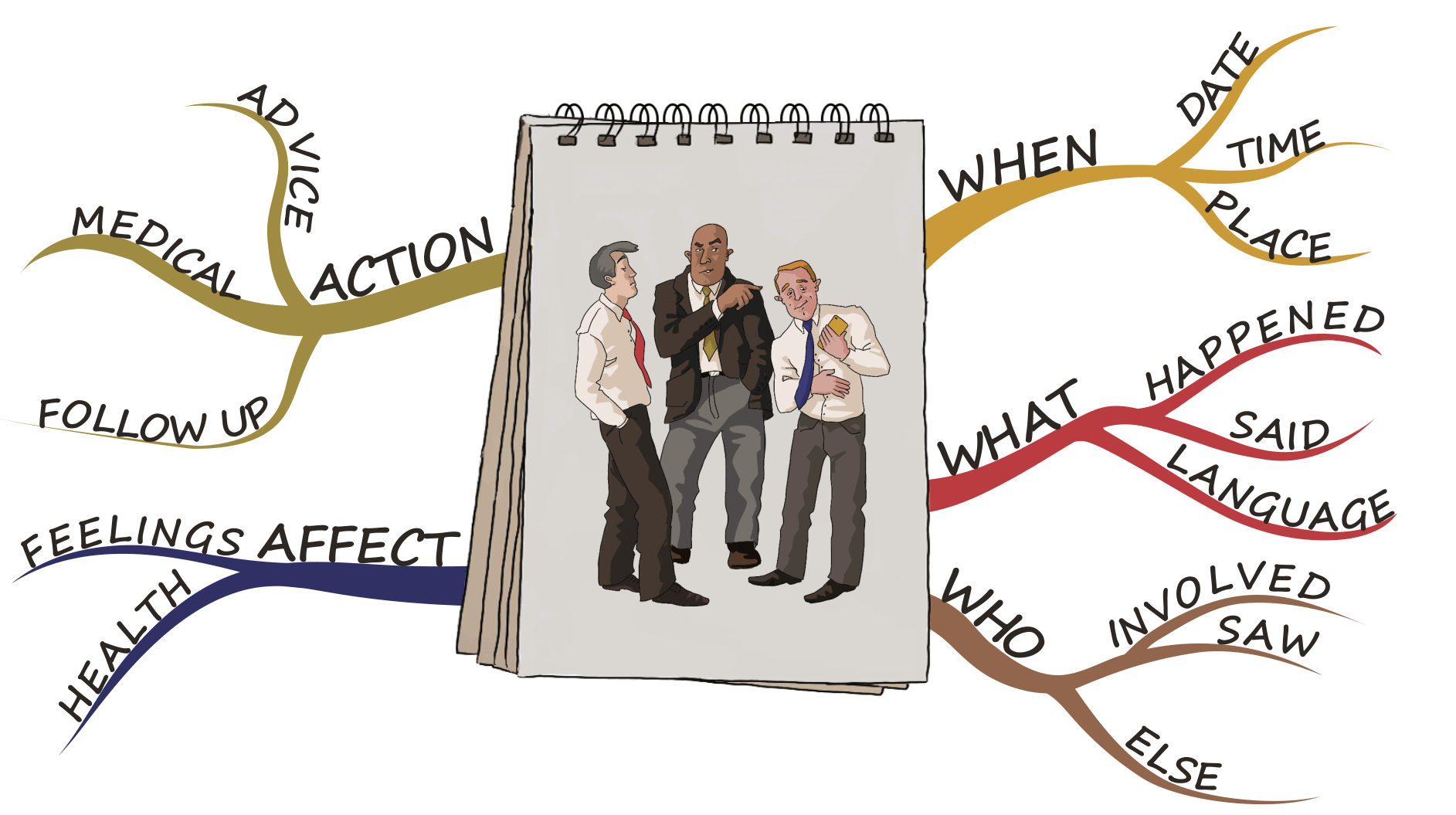Equality
Equality is about making sure people aren’t disadvantaged, discriminated against or excluded from full and fair participation.
Treating everyone in exactly the same way is not the same as equality. Some people might need more help to get the same chances. For example, if there were no provisions for wheelchair access, wheelchair users would be excluded.
Protected characteristics
There are nine protected characteristics:
• age
• disability (physical and mental)
• gender reassignment
• marriage and civil partnership (civil status)
• pregnancy and maternity
• race (including colour, nationality, ethnic or national origin)
• religion or belief (including no philosophical belief or religion)
• sex
• sexual orientation

Discrimination
You’ are protected from discrimination:
• at work
• in education
• as a consumer
• when using public services
• when buying or renting property
• as a member or guest of a private club or association.
Forms of discrimination
Direct discrimination
Treating someone with a protected characteristic less favourably than others.
Indirect discrimination
Putting rules or arrangements in place that apply to everyone, but that put someone with a protected characteristic at an unfair disadvantage.
You are also protected from discrimination:
- by association – you’re associated with someone who has a protected characteristic, for example a family member or friend
- if you’ve complained about discrimination or supported someone else’s claim.
Harassment and victimisation
Harassment
Unwanted behaviour linked to a protected characteristic that violates someone’s dignity or creates an offensive environment for them.
Victimisation
Treating someone unfairly because they’ve complained about discrimination or harassment.
Diversity
Diversity includes all of us, and all the ways we’re different.
Some of these can be visual differences, others can’t be seen. For example, a person’s cultural or social background.
| Often visible | Sometimes visible | Generally hidden |
| Gender | Nationality | Values |
| Race | Physical ability | Political views |
| Age | Ethnicity | Education |
| Language | Wealth | Heritage |
| Social status | Family status | |
| Religion | Life experience |
Inclusion
In order for a diverse group of people to work together successfully, the work environment needs to be one where everyone is able to contribute to their full potential, and where no one is defined by, or held back – because of their differences.
Attitudes are changing
Smoking in public buildings and offices used to be commonplace. Now it’s illegal. It’s hard to imagine many people wanting to return to those days.
What was once seen as normal, is now sometimes frowned upon or considered unacceptable. These changes are harder for some people to accept than others.
Unconscious bias
What we process consciously is only a very small part of the information we receive.
About 11,000,000 pieces of information a second, is handled by our unconscious mind.
We use patterns and shortcuts to help us process so much information so quickly.
From a basic human survival standpoint, our unconscious judgements or biases are necessary and essential. They helped alert us to danger and react quickly.
When there is no danger, these shortcuts can lead to poor decisions based on unfair biases.
When related to people, they’re often based on the way a person appears.
For example, age, appearance, gender or race, accent and the way they speak
Sometimes stereotyping people on their appearance can lead to decisions about them which are unfounded. For example, someone with tattoos is anti-establishment.
Studies have shown that people have been selected, or offered interviews because their name seems to fit in with they ‘type of person’ they are looking for, or their name doesn’t fit with the type of person they are looking for.
Sometimes this could be down to direct prejudice or discrimination. However, importantly, sometimes these choices are influenced by unconscious biases.
Unconscious biases are very hard to prove as people aren’t aware of the unconscious influences. However, a computer simulation can show how much influence a small percentage of bias can have when that bias is repeated over a period of time.
Being aware of an unconscious biases and adjusting for their possibility can lead to better decision making.
Vulnerable customers
The term vulnerable customer is used to describe someone who due to their personal circumstances, is especially susceptible to detriment, particularly when an organisation is not acting with appropriate levels of care.
Vulnerable customers may not see themselves as being vulnerable.
Personal circumstances fall broadly into three categories:
- A person’s health, mental and physical, as well as any disabilities.
- A person’s level of literacy, numeracy and language skills.
- Going through a significant life changing event such as a job loss, a divorce, or a bereavement.
Often there are a number of factors together which make a person vulnerable.
Reporting bullying and harassment
Bullying and harassment can appear in many forms. For example being:
- treated unfairly in an appraisal
- mocked
- excluded
- victimised
- …
Sometimes honest and innocent misunderstandings do occur.
How can you stop it?
One way is to speak to the person who is bullying or harassing directly, but there are many reasons why this isn’t always possible or desirable.
Before reporting, gather as much information as possible.

Who can you report bullying and harassment to?
Depending on your situation, one of the following might be the best option.
- Line manager
- A trusted person in authority within your organisation
- Human Resources department
- Union Representative
- Confidential whistleblowing hotline
External organisations
Search ‘report harassment at work’
Charitable organisations often have confidential phone lines, online chats, and email addresses you can use.
Everyone has the right to be treated with dignity and respect at work.
If you’re being affected by bullying or harassment:
- you’re not alone
- there are people who can help
- you can help them by giving them as much detailed information as possible.
